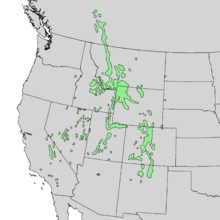Flexible jaw
| Flexible jaw | ||||||||||||
|---|---|---|---|---|---|---|---|---|---|---|---|---|

Flexible Pine ( Pinus flexilis ) |
||||||||||||
| Systematics | ||||||||||||
|
||||||||||||
| Scientific name | ||||||||||||
| Pinus flexilis | ||||||||||||
| E. James |

The flexible pine ( Pinus flexilis ), also known as the Nevada stone pine , is a slow-growing conifer that is native to the mountains of western North America. It rarely gets higher than 20 meters and reaches a maximum age of around 400 years.
description
The flexible pine is a 20 to 35 meter high tree with a loose, conical crown when young, broad and rounded when old, and shallow roots. The trunk reaches a diameter of 100 to 120 centimeters and is covered with a 2.5 to 5 centimeter thick scaly bark. The trunk stays short in the open. Usually the species grows multi-stemmed and crooked, even bushy at the tree line. The branches stand upright or are arching and ascending. Young shoots are yellow-green, glabrous or have short, brown hairs. They later turn light gray and remain pliable, which is what gave the species its name. The winter buds are about 1 centimeter long. They are broadly ovate and pointed. Five 4 to 8 centimeters long and 1 millimeter wide needles are formed on short shoots , which are arranged in brush-like, loose tufts. The 1.5 centimeter long needle sheaths fall off early. The needles are stiff, straight or slightly curved, almost triangular in cross-section and with entire margins with stomata on each side. The lifespan of the needles is 5 to 6 years.
The flexible jaw is monoecious . The male cones are about 1 centimeter tall and reddish. The female inflorescences are oblong-egg-shaped, stand upright and usually in groups of three and four together. The almost seated, shiny light brown and heavily resinified cones are 7 to 15 centimeters long and 4 to 6 centimeters wide. The hard-shelled seeds are 8 to 12 millimeters long and 7 to 8 millimeters wide. They are equipped with a 2 millimeter wide, soon sloping wing hem. The seeds ripen in the second year. The flowering time is in June and July, the seeds ripen in August and September.
The number of chromosomes is .
Distribution and location requirements
The flexible pine is native to an island-like fragmented area in western North America, in the Rocky Mountains , the California White Mountains and in the Sierra Nevada . They are found from southeastern British Columbia and southwest Alberta to California , Utah and Colorado, and east to North Dakota , South Dakota and southwest Nebraska . Isolated occurrences are found in northern Arizona and northern New Mexico .
It thrives on dry, nutrient-poor, flat to medium-sized sites on steep slopes at altitudes of 1000 to 3700 meters.
The Flexible jaw is in the red list of the IUCN out as not at risk ( "Lower Risk / Least Concern"). It is pointed out, however, that a new check of the risk is necessary.
ecology
The flexible pine seldom forms pure stands and is mostly associated with the Douglas fir and fir and spruce species. Like many other five-needle pines, it is very susceptible to rust .
Systematics
The flexible pine is assigned to the sub-genus Strobus in the genus of pines , there in the section Quinquefoliae of the sub-section Strobus . The first description of Pinus flexilis was in 1824 by Edwin P. James in WH Keating, Narrat. Exp. St. Peter's River, Volume 2, page 35. synonyms of Pinus flexilis E.James are Pinus cembra var. Flexilis (E.James) F.Sanders , Apinus flexilis (E.James) Rydb. , Pinus lambertiana var. Brevifolia Hook. and Pinus novaemexicana P.Landry . Hybrids can be found in the intersection of Pinus flexilis and Pinus strobiformis .
The cultivar 'Firmament' differs from the species in that it has shorter, uniformly gray-blue needles.
use
The wood is economically insignificant, but the flexible pine has a certain ornamental value because of the long, blue-green needles. It came to Europe in 1861 and is completely hardy in Central Europe. The seeds are similar to those of the stone pine and are also edible and tasty.
proof
literature
- Ulrich Hecker: Trees and Bushes . FSVO manual. BLV Buchverlag, Munich 2006, ISBN 3-8354-0021-5 , p. 82 .
- Peter Schütt , Hans Joachim Schuck, Bernd Stimm (eds.): Lexicon of tree and shrub species. The standard work of forest botany. Morphology, pathology, ecology and systematics of important tree and shrub species . Nikol, Hamburg 2002, ISBN 3-933203-53-8 , pp. 363 (reprinted 1992).
- Andreas Roloff, Andreas Bärtels: Flora of the woods. Purpose, properties and use . 3rd, corrected edition. Eugen Ulmer, Stuttgart (Hohenheim) 2008, ISBN 978-3-8001-5614-6 , pp. 764-765 .
Individual evidence
- ↑ a b c d e f g Schütt et al .: Lexicon of tree and shrub species , p. 363
- ↑ Roloff et al .: Flora of the Woods , p. 764
- ↑ a b c d e f Hecker: Trees and Bushes , p. 82
- ↑ a b Pinus flexilis. In: Flora of North America Vol. 2. www.eFloras.org, accessed September 18, 2010 .
- ↑ Elbert L. Little Jr .: Atlas of United States Trees online (PDF; 710 kB)
- ↑ Pinus flexilis in the endangered Red List species the IUCN 2010. Posted by: Conifer Specialist Group, 1998. Retrieved on 3 January 2011th
- ↑ Pinus flexilis. Germplasm Resources Information Network (GRIN), accessed September 18, 2010 .
- ↑ a b Rafaël Govaerts (Ed.): Pinus. In: World Checklist of Selected Plant Families (WCSP) - The Board of Trustees of the Royal Botanic Gardens, Kew . Retrieved April 24, 2019.
- ↑ Roloff et al .: Flora of the Woods , p. 765
Web links
- Christopher J. Earle: Pinus flexilis. In: The Gymnosperm Database. conifers.org, accessed October 20, 2011 .
- Thomas Meyer: Data sheet with identification key and photos at Flora-de: Flora von Deutschland (old name of the website: Flowers in Swabia )



